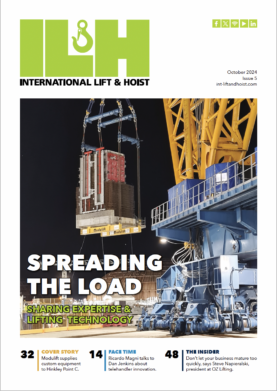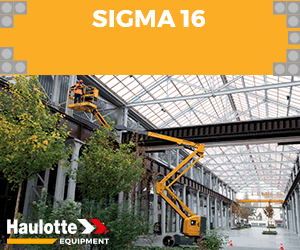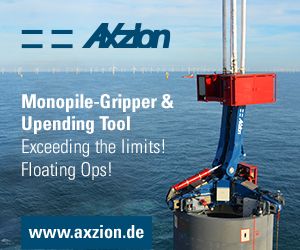Making Basement Work a Breeze: Altec’s customized AC26-103R rear-mount boom truck meets foundation contractor’s rigorous performance needs
Part One
When Altec Industries, Inc., Daleville, Va., entered the boom truck market, it made the decision to enter through an exclusive distribution agreement with Custom Truck and Equipment LLC (Custom), based in Kansas City, Mo. Although Custom is the sole distributor for the Altec Crane products, after-sales service and support is a joint effort between Custom and Altec's 21 factory service centers, which feature 160 mobile service technicians strategically located throughout North America to support the company's entire product line. One of Altec's cranes, the AC26-103, was introduced at the 2005 World of Concrete show. Our test unit, the AC26-103R, is the rear-mounted version of this machine, offering a 26-ton capacity with a four-section, 103-foot main boom.

Serving specialized applications
Let me begin by saying, this particular unit is a lot of truck. This AC26-103R is fitted with a 44-foot, two-section manual telescoping swing-away jib. Beyond these standard specifications, this particular installation is anything but ordinary. Custom made some major modifications to this unit, all at the request of the buyer. On the day of my visit, it was being delivered to its proud new owner Jones Construction Co. (Jones), a residential foundation contractor located in Town of Norway, Wis., just outside of Milwaukee. What made Jones turn to Custom for a solution to its construction challenges?
Because the bulk of the contractor's work uses aluminum forms for pouring basement walls in place, Jones wanted a unit that could carry as many of these forms as possible, set them close to the job, and place the concrete in those forms via a concrete hopper. Jones' main problem was that the peak part of the building season falls in the spring – when the ground is at its wettest, causing traction to be a huge issue. As you can see in Image 1, Altec's AC26-103R has taken on this challenging basement work head on.

Customization is key
As it happens, the unit featured in this equipment review is the first rear-mount configuration of the AC26-103R to be delivered. As you can see in Images 2 and 3, this is no typical installation. The single biggest customization was made to the drive system. That third axle is not the tag axle you see; it is a tri-drive (8X6 configuration) custom fitted by Custom. These are Dana Spicer axles, riding under a Peterbilt 357 chassis with a 475-hp Caterpillar C15 engine mated to a 16-speed Spicer transmission.
Custom likes this axle set up for many reasons – two of the biggest being the dual-capacity enhancements that come from the extra axle. The easiest way to add extra payload to a truck is to add a fourth axle. Typically, it would be a free-floating tag axle. As Custom's President Fred Ross stated, a tag axle is just dead weight. A tri-axle drive gives you not only the extra carrying capacity but also the added traction and power of an additional drive axle. It is also a great alternative to a powered steering axle. According to Ross, this configuration saves as much as 7,500 pounds in added weight when compared to a set up that uses a typical powered steering axle. Of course every pound saved here increases the amount of payload the chassis can carry. This is very important to the folks at Jones, as they need to carry as many of the concrete forms as possible when traveling to jobsites. The tri-axle configuration coupled with the rear-mount boom allows Jones' crew to back the truck into just about any jobsite condition, putting the truck and the reach of the rear-mounted crane closer to the work.
Another very important feature for Jones was the clearance height of the boom when it was in the stowed position. The greater the clearance between the bottom of the boom and the bed maximizes the number of concrete forms that can be carried. These forms are 8'x36” and are stacked like cards. Ideally, the crew likes to carry as many as 120 of them on the bed itself. Many more can be stowed on a special tag trailer that they pull behind the rig, which is part of the reason they speced the big Cat engine. Again, Custom answered this need by cutting the cross members out of the standard bed and dropping it 5 inches (Image 4). Lowering the bed meant lower profile tires would be needed, so 11R X 22.5 Bridgestones are utilized to keep the tolerances required.
Next issue we will discuss all the features of the AC26-103R and get first-hand operational impressions from the owner and operator of this particular unit.
Part Two
Altec Industries, Inc., Daleville, Va., is renowned for the standards it has set for safety in the utility lift business • a philosophy that's been carried through to its boom truck products. As discussed in Part One, the subject of this equipment review is modeled after the Altec AC26-103 boom truck, which was introduced in 2005 at the World of Concrete. The rear-mounted version of this crane, the AC26-103R (Image 1), offers a 26-ton capacity with a 4-section, 103-foot main boom and was fitted with a 44-foot, two-section manual telescoping swing away jib. This is not your normal installation • the biggest departure being the tri-axle drive installed by Altec's distributor Custom Truck and Equipment, Kansas City, Mo.
Although not as significant as the tri-drive, there are several other modifications that have been made to this machine for easy operation. For example, as shown in Image 2, the walkaround platform across the rear of the bed allows easy access to the dual control stations located on each side of the bed. This unit is also fitted with a hydraulically driven generator for power tools • or in this case, supply power for working lights.
Aside from all the Custom Truck and Equipment-installed features, there are several standard Altec-incorporated features that will put a smile on the face of any owner or operator.
For durability and easy of service, all bearings in the boom are sealed. On
this unit, both the swing box and the winch are supplied by Tulsa Winch, Tulsa, Okla. With the power takeoff engaged, 100% of the hydraulic oil is filtered. This occurs at all times and at all engine speeds. The operating system is set to run at 4,200 psi maximum pressure. Winch pressure is set to top out at 4,000 psi max. Access to the control valves is easy via a large panel at the rear of the boom.
Altec refers to its Load Moment Indicator or LMI system as the Load Management Area Protection system, or LMAP. Note in Image 3 that the cable for the LMAP is routed back to the rear of the boom and then travels back to the front inside the boom.
There is also a remote winch stow system (Image 4), controlled with a toggle switch that is located up front next to the grill of the cab. This feature allows the operator to stow the hook and tighten the cable for transport from this position. To prevent over-tensioning of the cable, hydraulic pressure relief is designed into the circuit.
Hose and wire protection has been given proper attention, as demonstrated in Image 5. After crawling all over and under this unit, I discovered that even in the most obscure areas sheaves and hose guards are used in virtually every place conceivable to minimize wear
and failure.
Standard safety features include a Load Moment and Area Protection LMAP system (Image 6) described earlier. Developed by Altec and produced by Greer Electronics, this tool ensures that an audible warning system notifies the operator whenever the limits of the predefined work area are approached. This system is standard across the entire Altec line so that orientation is common on all their booms.
Both A frame, at the rear, and conventional 90-degree outriggers are utilized. Interlocks prevent operation without having all four in the full out and down position. Their location is monitored with the use of proximity switches, and a motion alarm warns of their movement. Dual holding valves are found on all critical hydraulic cylinders. For precise spooling control, a drum rotation indicator is also standard as well as an anti-two block device. This unit was also equipped with a radio remote control, which allows expanded flexibility.
In addition to a standard two-speed winch, the controls are Parker supplied and pilot controlled throughout the operating system. These use short throw joysticks (Image 7) for more precise metering. Operator Jim Cychosz of Jones Construction, Town of Norway, Wis., appreciates this feature. As we discussed in Part One, Jones is the company that purchased this particular unit. Cychosz gave the control system high marks, characterizing it as an awesome crane. “The dual controls allow complete control with two hands,” said Cychosz, adding that you don't have to move the two shorter/smaller joystick controls (Image 8) as far to get the response you desire.
This control design, coupled with a high output (98 gpm at 1,600 rpm) Casapa gear pump, delivers true multifunctionality. Jones is now using the crane daily and plans to purchase another as soon as possible. Common applications for the company include backing up to the job, swinging the boom around and telescoping it out. Cychosz notes that the rear-mount boom is working out nicely, providing an extra 15 to 20 feet of reach.
"Reach is the whole thing for us,” said Cychosz. "A sign company can park right next to a sign, but basements can be 90 feet long, and we are limited to parking on the job with dirt piles and holes in the way."
With the tri-drive and Cat engine, this crane moves around on soft ground, which has been a problem with other cranes because there isn't enough weight in the front. Locking in the tri-drive, the Altec can go through the soft ground. "When you get into the mud, other trucks won't turn,” said Cychosz. “With the rear-mounted crane in the cradle, extending the boom in the cradle adds weight to the front tires, and you don't need the front to be powered."
Cychosz also noted the automatic idle increase is an improvement on setup. "When you start operating the downriggers, it senses they're going down, and the engine automatically idles to make the outriggers go down quicker," he said.
Jones has been quite complimentary of the Altec crane but has saved its biggest accolades for the work Custom did in building the exact crane they wanted.











